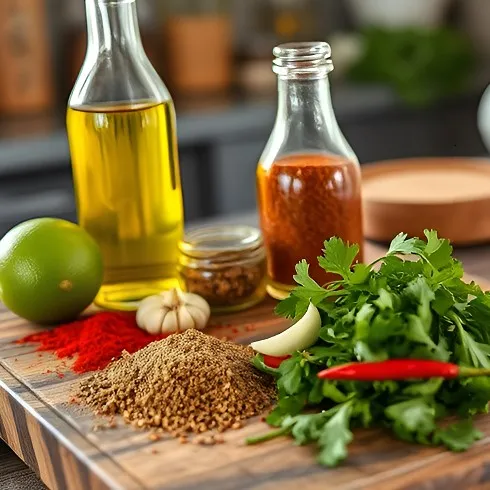Few dishes capture the vibrant spirit of Tex-Mex cuisine quite like fajitas—and at the heart of a truly unforgettable fajita lies a perfect marinade. Over the years, this Fajita Chicken has evolved from a simple cowboy meal to a gourmet experience that delights both the palate and the senses. Today, we’re diving deep into the secrets of crafting the ultimate fajita chicken marinade. Whether you’re a seasoned home cook or a curious beginner, this guide will help you master a marinade that infuses tender Fajita Chicken with layers of flavor, ensuring your fajitas stand out at every meal.
Table of Contents
The Legacy and Allure of Fajitas
Fajitas have a fascinating history rooted in the ranch lands of Texas. The term “fajita” comes from the Spanish word faja, meaning “belt” or “girdle,” originally referring to the skirt steak cut favored by vaqueros. Over time, the concept evolved, and today it embraces a variety of lean proteins—most notably, chicken—paired with sizzling bell peppers, onions, and an array of flavorful accompaniments. This dish’s communal style, where everyone assembles their own fajitas, makes it the perfect centerpiece for gatherings and family dinners alike.
The true magic lies in the marinade. A well-crafted marinade doesn’t just tenderize the meat; it transforms each bite into a symphony of tangy, savory, sweet, and spicy notes. With every ingredient playing its part, the marinade is both an art and a science—a culinary secret that turns simple chicken into a meal worthy of celebration.
The Foundation of Flavor: What Makes a Great Marinade?
At its core, a great marinade combines contrasting elements to achieve a harmonious balance. Let’s break down the essential roles each component plays in creating that irresistible flavor:
The Science Behind Marinades
The magic of marinades begins with understanding how each ingredient contributes to flavor, texture, and moisture:
- Acidic Components: Ingredients like lime or lemon juice and various types of vinegar work to break down muscle fibers. This not only tenderizes the meat but also imparts a bright, tangy flavor that cuts through the richness of the chicken.
- Oils: A good oil—think extra-virgin olive or avocado oil—distributes fat-soluble flavors throughout the meat and creates a barrier that helps retain juices during cooking.
- Spices & Herbs: The backbone of the marinade, spices like chili powder, cumin, and paprika, along with herbs such as cilantro and oregano, introduce layers of complexity, depth, and aroma.
- Sweeteners: A dash of honey, brown sugar, or agave syrup creates a balancing act, mellowing out the acidity and heat while promoting that desirable caramelization when cooked.
- Salt: Beyond enhancing flavor, salt helps the meat retain moisture—a critical element for achieving tender, juicy fajita chicken.
Understanding these principles is key to devising a marinade that not only flavors the chicken to perfection but also elevates the overall dining experience.
Key Ingredients: The Heart of Your Fajita Marinade
In creating a fajita chicken marinade, selecting high-quality ingredients is as important as knowing the role each plays. Let’s take a closer look at these building blocks.
Acidity: Bringing Brightness and Tenderness
For a classic fajita marinade, lime juice stands out as an ideal acidic partner. Its citrus brightness cuts through the savory spices and tenderizes the chicken fibers simultaneously. Alternatives like lemon juice or mild vinegars (apple cider or even white vinegar) can be used either solo or in combination, depending on the flavor profile you’re aiming for. The balance is crucial—too much acid can raise the risk of mushy meat, so moderation is key.
Oil: The Conductor of Flavor
No marinade is complete without a quality oil. Olive oil is a popular choice, offering a rich, mildly fruity undertone that marries well with the spices. Avocado, grapeseed, or sunflower oil can serve as excellent alternatives if you prefer a more neutral flavor or higher smoke points for grilling. The oil helps to deliver the flavors evenly while keeping the chicken moist during high-heat cooking.
Spices and Herbs: The Soul of Tex-Mex Cuisine
Fajitas are defined by their robust and fiery flavor, and the spice blend is what delivers that punch. Essential spices include:
- Chili Powder: Provides warmth and that classic Tex-Mex heat.
- Cumin: Adds a rich, earthy, and slightly nutty aroma.
- Paprika: Lends a sweet, smoky note and a vibrant red hue.
- Garlic and Onion Powder: These powders boost the umami and impart a savory depth.
- Oregano: Offers a herbal, slightly bitter accent that balances the other elements.
Fresh herbs like chopped cilantro not only intensify the flavor but also introduce a refreshing brightness that lifts the Fajita Chicken .

Sweetness and Salt: Balancing the Equation
A slight touch of sweetness—whether from honey, brown sugar, or agave—acts as the perfect counterpoint to the acidity and heat. It’s these subtle sweet notes that help with browning and create a caramelized exterior while cooking. Salt, on the other hand, stitches all these flavors together, ensuring every bite is well-seasoned and flavorful. When executed correctly, this balance of sweet and salty transforms a simple marinade into something spectacular.
Step-by-Step: Crafting the Ultimate Fajita Chicken Marinade
Creating a marinade that sings with flavor involves a series of thoughtful steps. Here’s a comprehensive guide to assembling your marinade from scratch:
Step 1: The Base—Combining Acid and Oil
Begin with the liquid elements. In a large mixing bowl, blend freshly squeezed lime juice (or your chosen acidic ingredient) with a generous amount of olive oil. This vibrant base forms the canvas on which your spices and flavors will be built.
Step 2: Introducing the Aromatics
Next, add your carefully measured spices: chili powder, cumin, paprika, garlic powder, onion powder, and oregano. Whisk these into the acid-oil blend until they are fully incorporated. This step ensures that every drop of your marinade carries a consistent mix of flavors.
Step 3: Balancing with Sweetness and Savory Salt
Now, introduce a small measure of your chosen sweetener—be it honey or brown sugar—to mellow out the acidic bite. Sprinkle in a clean grind of kosher or sea salt. Stir vigorously, ensuring the salt dissolves and the ingredients meld into a cohesive mixture.
Step 4: The Fresh Herb Finale
For that extra aromatic lift, fold in finely chopped fresh cilantro (or your herb of choice). The fresh green notes of cilantro not only enhance the flavor but also add a pop of color that hints at the freshness of the final dish.
Step 5: Marinating the Chicken
Arrange your chicken pieces—whether breasts, thighs, or even a mix—in a resealable plastic bag or a shallow, non-metallic dish. Pour the marinade over the chicken, ensuring every surface is touched. Seal the bag or cover the dish, then refrigerate for a minimum of two hours. For maximum flavor penetration and tenderness, marinating overnight is ideal, but avoid exceeding 24 hours to prevent the chicken from becoming too soft.

Advanced Techniques for Flavor Enthusiasts
As your kitchen confidence grows, you might be ready to experiment with advanced techniques that can intensify the flavor infusion of your marinade.
Vacuum Marinating
Using a vacuum sealer to marinate chicken dramatically reduces the time needed for flavor infusion. This method removes the air around the meat, allowing the marinade to permeate more deeply and evenly, resulting in a noticeably more flavorful and tender product—even with shorter marinating times.
Marinade Injection
For thicker cuts of meat, consider using a marinade injector. This tool allows you to infuse the marinade directly into the interior of the chicken, ensuring that every bite is as flavorful as the surface. It’s a neat trick that guarantees consistent results, especially when dealing with lean cuts.
Sous Vide Marination
Another modern twist is sous vide marination. By sealing the chicken and marinade in a vacuum bag and cooking it at a precise low temperature, you ensure an even, restaurant-quality tenderness throughout the meat. This method not only locks in flavors but also offers a fail-safe way to prevent overcooking.
Cooking Methods: Bringing Your Marinade to Life
After a patient marination process, the next step is cooking the chicken with a method that enhances the marinade’s magic.
Grilling: The Iconic Tex-Mex Experience
For many, grilling is synonymous with fajitas. Preheat your grill to medium-high, lightly oil the grates, and cook the marinated chicken for approximately 6–7 minutes per side. The result is a smoky char that perfectly complements the tangy and spicy notes of your marinade. Grilling on charcoal can add an extra layer of smokiness, while gas grills offer consistent and controllable heat.
Sautéing: Quick and Flavorful
When time is short, sautéing in a cast-iron skillet can produce rapid yet delicious results. Heat a generous splash of oil over medium-high heat and sauté the chicken until golden on both sides—roughly 5–6 minutes per side. This method works particularly well with lean cuts like chicken breasts and is ideal for busy weeknights.
Baking: Mastering the Even Heat
For those who prefer a hands-off approach, baking is an excellent option. Preheat your oven to 400°F (200°C) and arrange the chicken on a baking sheet lined with parchment paper or a silicone mat. Bake for 20–25 minutes until the internal temperature hits 165°F (74°C). Baking ensures even heat distribution, which helps maintain a tender, juicy texture throughout the meat.
Broiling: Quick Caramelization
Broiling provides many of the same benefits as grilling, using high heat from above to create a beautifully caramelized exterior. Place your chicken on a broiler pan or a wire rack set over a baking sheet and broil for 4–5 minutes per side. Keep a close watch to avoid overcooking, and ensure that the meat reaches the safe temperature before serving.
Tantalizing Serving Ideas: Reinventing the Fajita Tradition
Once your chicken is perfectly marinated and cooked, it’s time to transform it into a complete meal. Fajitas offer incredible versatility, making them suitable for a range of creative serving styles

Classic Fajitas
The traditional method involves serving the sliced chicken with warm tortillas, sautéed bell peppers, and onions. Accompany these with a selection of toppings—fresh salsa, guacamole, sour cream, and shredded cheese—to allow each diner to build their own fajita masterpiece. This interactive style invites everyone into the cooking process and ensures a convivial, personalized dining experience.
Fajita Bowls
For a modern twist, consider constructing a fajita bowl. Start with a base—whether it’s rice, quinoa, or even cauliflower rice for a low-carb option—then crown it with black beans, corn, chopped tomatoes, and fresh avocado. Top the bowl with sliced chicken and a drizzle of zesty dressing, garnishing with lime wedges and extra cilantro. This deconstructed approach not only looks appealing but also caters to meal prep routines and healthier eating.
Tacos and Wraps
If you’re in the mood for something handheld, transform your fajita chicken into tacos or wraps. Soft flour tortillas, crispy corn tacos, or even whole wheat wraps can cradle the flavorful filling. Add layers of fresh lettuce, diced tomatoes, and shredded cheese, then drizzle with your favorite hot sauce or creamy chipotle dressing. This portable option makes it easy to enjoy your meal on the go.
Fajita-Stuffed Vegetables
For a creative spin that boosts your daily vegetable intake, try stuffing large bell peppers, zucchini, or tomatoes with your fajita chicken mixture. Hollow out the veggies, fill them with a mix of sautéed chicken, peppers, onions, and a sprinkle of cheese, then bake until the vegetables are tender and the cheese is delightfully melted. This presentation not only tastes fantastic but also makes for an impressive, restaurant-quality Fajita Chicken dish.
Variation and Customization: Tailor Your Marinade to Your Taste
One of the most delightful aspects of a fajita chicken marinade is its flexibility. With a few tweaks, you can adjust the flavor profile to match your mood, dietary needs, or even a particular theme.
Turning Up the Heat
If you prefer a spicier kick, amplify your marinade with extra chili powder, a pinch of cayenne pepper, or even fresh diced jalapeños. A splash of your favorite hot sauce can also intensify the overall fire in the Fajita Chicken. Adjust the spice levels gradually, tasting as you go, so you don’t overpower the more delicate notes.
Citrus and Beyond
While lime is the classic choice, feel free to experiment with other citrus fruits. A mix of orange or grapefruit juice can add layers of unexpected sweetness or tang, resulting in a multi-dimensional marinade that balances tartness and lively flavor. Combining different citrus juices may surprise you with a new twist on an old favorite.
Herbs for a Fresh Twist
Beyond cilantro, herbs like thyme, rosemary, or even basil can alter the marinade’s character. Think of adding rosemary for a more robust, woodsy aroma or basil for a sweet, peppery note reminiscent of Mediterranean dishes. Experimenting with herbs allows you to tailor your marinade to match different styles of cuisine while keeping the essence of fajitas intact.
Sweet Meets Savory
Sometimes you might crave a marinade that dances between just the right amount of sweet and savory. Try pairing honey with a dash of soy sauce or maple syrup with a splash of balsamic vinegar. This blend creates a tantalizing overcoat on the chicken that balances the acidity and spices while encouraging beautiful caramelization during cooking.
Nutritional and Sustainability Considerations
A thoughtful marinade isn’t just about taste; it’s also an opportunity to create a healthier, more conscientious meal. Choosing lean chicken cuts, monitoring your oil and sweetener usage, and emphasizing fresh, organic ingredients all contribute to a nutritious meal that you can feel good about serving.
Opt for organic chicken when possible—a decision that supports higher welfare standards and reduces exposure to unwanted additives. Complement your protein with a rainbow of vegetables in your fajita mix, ensuring your plate is as visually appealing as it is nutrient-dense. And don’t forget whole grain options like brown rice or whole wheat tortillas to boost the fiber content and energy sustainment of your meal.
While planning your ingredients, consider the environmental impact of your choices. Support local producers when you can, choose ingredients with eco-friendly packaging, and aim to minimize food waste by saving extra marinade (after proper cooking) or repurposing leftovers into creative new dishes.
Storing, Reusing, and Pairing: Making the Most of Your Marinade
One of the practical benefits of a well-made marinade is its versatility—even after your chicken has been cooked. With a few safety steps, you can transform leftover marinade into a savory sauce or freeze it for later use in your culinary adventures. If you plan to repurpose any marinade that has come into contact with raw chicken, always bring it to a rolling boil for at least five minutes to eliminate any risk of cross-contamination.
Beyond the marinade itself, think about what to serve alongside your fajita chicken. Consider sides like Mexican rice, black beans, or a vibrant corn salad. Light drinks—such as a refreshing agua fresca or a classic margarita—can round out the meal beautifully. Even dessert has a place here: a serving of churros or a slice of tres leches cake can provide the sweet finale after a richly spiced main course.
Frequently Asked Questions About Fajita Chicken Marinade
Can I use other meats for fajitas?
Absolutely. While chicken is a popular choice, you can swap in skirt steak, flank steak, pork, shrimp, or even plant-based proteins like tofu or tempeh. Adjust the marinating time and spice levels as needed for the protein you choose to maintain both flavor and tenderness.
How long should I marinate my Fajita Chicken?
For optimal flavor, allow the chicken to marinate for at least two hours. Overnight (up to 24 hours) is ideal, but be cautious not to exceed this timeframe, as too much acid can begin breaking down the meat excessively, leading to a mushy texture.
Is it safe to marinate vegetables with the same marinade as the chicken?
You can indeed marinate vegetables alongside the chicken, but because they absorb flavors much faster, it might be better to add them near the end or marinate them separately. This technique prevents the vegetables from becoming overly soft and maintains their natural crunch.
Can leftover marinade be used as a sauce?
Yes, but always reserve a portion of the marinade before adding raw chicken or bring it to a rolling boil for several minutes if it has been in contact with the raw meat. This step ensures all harmful bacteria are eliminated, making it safe to drizzle over your finished Fajita Chicken dish.
Is fajita chicken gluten-free?
Fajita chicken can certainly be made gluten-free. Just double-check that all used ingredients—including spice blends and tortillas—do not contain hidden gluten sources. Reading labels carefully helps prevent any unwanted surprises.
Conclusion: A Culinary Journey Worth Savoring
Crafting the ideal fajita chicken marinade is more than following a recipe—it’s an exploration of flavors, traditions, and techniques that celebrate the vibrant heritage of Tex-Mex cuisine. From understanding the science behind each ingredient to experimenting with advanced marinating techniques, every step is an invitation to elevate your culinary game. Whether you’re opting for a smoky grilled finish, a quick sauté, or even a perfectly baked entry, the marinade is your secret weapon for creating fajitas that burst with flavor and personality.

